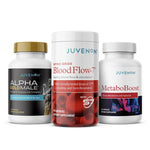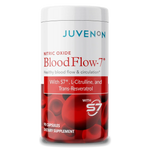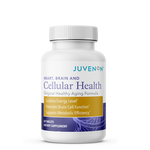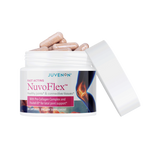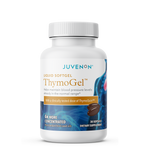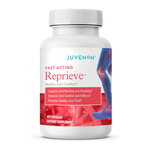
Ever had the winter blues?
It’s not an uncommon phenomenon. In fact, according to the American Academy of Family Physicians, up to 26 percent of people may experience significant feelings of sadness seasonally.[1]
What’s more, you’re at a greater risk the further north you live! They say that people who live in Washington state are seven times more likely to experience the winter blues than people who live in Florida.
Fortunately, there are ways to help alleviate the winter blues naturally, so you can fully enjoy the winter season and recapture some of the magic of it.
In this article you will learn:
- What the winter blues are
- Why and how they happen, and what causes them
- How exercise and light therapy may help with the winter blues
- And how the right supplement can improve mood and boost “happy hormone” production year-round
What are the winter blues?
“Winter blues” doesn’t have an official definition, but it is a unique feeling of sadness or listlessness that many people feel in the wintertime. It can range from mild feelings to a condition called seasonal affective disorder (which only occurs during certain seasons) to full-blown depression.
It can have a variety of causes, too. The holiday season is difficult for many people for a myriad of reasons, and sometimes the winter blues could more aptly be called the “holiday blues.”
However, researchers also suspect that the seasons themselves affect mood. A key suspect is light. Sunlight and darkness dictate our circadian rhythms, which is the natural rhythm of our hormones throughout the day to help us stay awake in the daytime and go to sleep at nighttime.
The increased darkness during the winter affects hormones because of our circadian rhythm, and hormones are a major influencer of our moods. [2]
Curious if you or someone you love experiences the winter blues? Here are some common signs you might:
- Chronic sadness and depression that lasts longer than a few hours and comes seasonally
- New and intense craving for carbohydrate-rich foods
- Erratic sleeping behavior (either too much or too little)
- Sensation of physical heaviness and fatigue in your body
- Lack of motivation or ability to concentrate
- Withdrawal from activities that typically bring you joy
- Social isolation
- Increased substance use
If you have symptoms of “the winter blues” it’s important to speak to a qualified professional – don’t diagnose yourself. Oftentimes, this mood disorder is part of a bigger mental health issue and needs proper attention.
Serotonin and sadness
Serotonin, known as the “happy hormone,” is one of the key regulators of our mood and outlook.[2]
However, it tends to go through seasonal cycles. Even in people who don’t have seasonal affective disorder or the winter blues, serotonin levels tend to be at their lowest in the months of December and January. [2]
Because serotonin dictates feelings of happiness, satisfaction, pleasure, and contentment, lower levels may dampen your mood—leaving you feeling sad, listless, or unmotivated. There are many non-invasive ways to boost serotonin. Learn more here.
Natural strategies to manage the winter blues
Fortunately, there are some strategies that may help to boost serotonin naturally to stave off feelings of sadness and help maintain a more positive mood.
Exercise
The first is regular exercise. Although exercise has several physical benefits, it also provides some powerful benefits for cognitive function and mental health.
Researchers have found that exercise may regulate serotonin levels in the same way that antidepressant medications do. Regular exercise, they theorize, may also help to “train” the brain to produce higher levels of serotonin. This can offer improvements in mood, cognition, and sleep. [3, 4]
However, over-exercise can do the opposite and harm these serotonin pathways, causing more stress to the body. [4]
The Physical Activity Guidelines for Americans recommend 150-300 minutes of moderate intensity exercise each week, in addition to twice-weekly resistance training. [5]
However, any amount is better than nothing, and it’s important that you don’t overexert yourself because that can do more harm than good. Start slow and work your way up as your stamina and strength improve.
Light therapy
One treatment that may help with serotonin levels, particularly in the darker winter months, is light therapy using a specialized ultraviolet (UV) lamp. These lamps emit bright light that mimics sunlight, helping to regulate serotonin levels and Circadian rhythm. [6]
They are commonly used for the treatment of seasonal affective disorder, however, you may benefit from using a light therapy lamp even if you only have a mild case of the winter blues.
Additionally, light therapy may also help to prevent the winter blues to begin with. It’s easy to do, too—just sit near the lamp while it’s powered on for a set time every day, usually no more than 10-30 minutes.[7]
As an alternative to light therapy (if it’s appropriate for your winter climate), make it a point to spend some time outside during the warmest and brightest part of the day—which is usually around lunchtime. In addition to light exposure that can help to regulate your Circadian rhythm, being outdoors is another great mental health booster.
How SeroLastin can help
A final, powerful strategy to help improve your serotonin levels and manage or prevent the winter blues is to take a targeted, specially formulated supplement. Juvenon’s SeroLastin is one such supplement, designed specifically to address serotonin. You can take it year-round for a continuous lift or take it seasonally to help combat chilly winter moods.
It’s made with high quality ingredients that have been scientifically researched to help with serotonin and mood, like B vitamins and potent botanicals and herbs.
Here’s how each ingredient in SeroLastin works to lift your mood.
B vitamins
SeroLastin is made with the B-vitamins folate, vitamin B6, and vitamin B12. The major role of B vitamins in the body is to help transform raw materials (food) into a form that the body can use for energy. However, they also have a number of supportive roles, too.
In people with a certain type of gene mutation known as the methylenetetrahydrofolate gene mutation, or MTHFR, folic acid absorption can be impaired—which allows for the build-up of a compound known as homocysteine. Homocysteine can damage the brain over time, and researchers have also noted that the MTHFR gene mutation is associated with depression.[8, 9]
Fortunately, the right form of folate (methylated folate) can be absorbed by people with MTHFR, and this folate helps to reduce homocysteine levels. This methylated folate is the type included in SeroLastin. Likewise, vitamins B6 and B12 help to regulate homocysteine levels. [8, 9, 10, 11]
Additionally, researchers have noted that people with depression are more likely to have low levels of B6 and B12 in their blood. In women, supplementation with vitamin B6 has been shown to reduce anxiety, as well. [8, 12, 13, 14]
SeroLastin provides optimal amounts of all three of these B-vitamins in easy-to-absorb forms that allow your body to utilize them effectively.
Alpinia galanga root
A. galanga is a relative of ginger, with roots that are highly prized for their powerful medicinal properties.
While it doesn’t appear to directly modulate mood or reduce anxiety levels, it does boost cognitive function—helping with things like memory, focus, concentration, and fatigue—in some animal trials. [15, 16]
One human study also noted that A. galanga helped with focus with or without caffeine, and that when taken with caffeine it helped to prevent the post-caffeine “crash.” [17]
Because fatigue and lack of focus also accompany the winter blues, a brain boost can be helpful.
Ashwagandha
Ashwagandha is a medicinal herb known as an adaptogen. It has a long history of use in Ayurveda, or traditional Indian herbal healing.
Adaptogens help the body to adapt more effectively to stressful circumstances (hence their name), potentially helping you to be more resilient even when under mental or physical stress. This improved flexibility and resiliency can be a huge help for preventing or warding off the winter blues.
One small study found that ashwagandha helped to reduce anxiety symptoms even further in people already taking antidepressant medications. [18]
Animal studies have also noted that ashwagandha could up-regulate (or activate) serotonin receptors, providing similar effects as serotonin, in addition to increasing circulating serotonin and dopamine (“pleasure hormone”) levels.[19, 20]
Saffron
Finally, SeroLastin also contains the potent medicinal herb saffron. Saffron is a prized spice made from the vibrant red flowers of the Crocus sativa plant, with the unique distinction of being the single most expensive spice in the world. High quality saffron can cost over $2,000 per pound.
It’s no surprise, then, that a little bit of saffron can go a long way.
Studies have shown that saffron can be just as effective as certain conventional treatments for mood issues. It works by inhibiting the reuptake of serotonin into the cells, which effectively keeps levels of serotonin circulating in the brain higher than they would be otherwise. [21, 22]
Saffron also carries with it a significantly lower risk of side effects or complications. [23]
That’s why saffron is the critical ingredient in SeroLastin that allows it to deliver such powerful stress-reducing effects.
Takeaway
The winter blues are a common occurrence in the colder months. This could be due to a variety of reasons, but one key player is likely the “happy hormone” serotonin. Serotonin production is influenced heavily by circadian rhythms, so they’re naturally at their lowest during the winter months of December and January—when we are getting the least amount of sunlight of the year.
However, this doesn’t mean it’s necessarily something you just have to accept. Exercise is an excellent way to naturally lift your mood, and regular exercise may even train your body to produce larger amounts of serotonin.
Additionally, light therapy using specialized lamps is an accepted method of preventing and treating seasonal affective disorder and may help with more minor cases of the winter blues as well.
Finally, you should consider including SeroLastin in your winter routine. This potent supplement is made from ingredients that are scientifically studied to help improve mood, enhance cognition, and preserve circulating serotonin—like B vitamins, A. galanga root, ashwagandha, and saffron.
With a proactive winter routine to help optimize your mood, the colder months don’t have to be so blue.
If you have severe Seasonal Affective Disorder or feel that your “winter blues” is worsening even after trying the aforementioned, please reach out and ask for professional help. If you or someone you love is considering suicide, please call the Suicide and Crisis Lifeline, at 988.
References
- American Family Physician. Seasonal affective disorder. AAFP website. Retrieved from https://www.aafp.org/afp/2000/0301/p1531.html
- Gupta A, Sharma PK, Garg VK, Singh AK, Mondal SC. Role of serotonin in seasonal affective disorder. Eur Rev Med Pharmacol Sci. 2013;17(1):49-55.
- Melancon MO, Lorrain D, Dionne IJ. Exercise and sleep in aging: emphasis on serotonin. Pathol Biol (Paris). 2014;62(5):276-283. doi:10.1016/j.patbio.2014.07.004 4.
- Wipfli B, Landers D, Nagoshi C, Ringenbach S. An examination of serotonin and psychological variables in the relationship between exercise and mental health. Scand J Med Sci Sports. 2011;21(3):474-481. doi:10.1111/j.1600-0838.2009.01049.x 5.
- U.S. Department of Health and Human Services. Physical Activity Guidelines for Americans, 2nd edition. Washington, DC: U.S. Department of Health and Human Services; 2018. Retrieved from https://health.gov/sites/default/files/2019-09/Physical_Activity_Guidelines_2nd_edition.pdf 6.
- Pjrek E, Friedrich ME, Cambioli L, et al. The Efficacy of Light Therapy in the Treatment of Seasonal Affective Disorder: A Meta-Analysis of Randomized Controlled Trials. Psychother Psychosom. 2020;89(1):17-24. doi:10.1159/000502891 7.
- Nussbaumer-Streit B, Forneris CA, Morgan LC, et al. Light therapy for preventing seasonal affective disorder. Cochrane Database Syst Rev. 2019;3(3):CD011269. Published 2019 Mar 18. doi:10.1002/14651858.CD011269.pub3 8.
- Coppen A, Bolander-Gouaille C. Treatment of depression: time to consider folic acid and vitamin B12. J Psychopharmacol. 2005;19(1):59-65. doi:10.1177/0269881105048899 9.
- Graydon JS, Claudio K, Baker S, et al. Ethnogeographic prevalence and implications of the 677C>T and 1298A>C MTHFR polymorphisms in US primary care populations. Biomark Med. 2019;13(8):649-661. doi:10.2217/bmm-2018-0392 10.
- Malouf R, Grimley Evans J. The effect of vitamin B6 on cognition. Cochrane Database Syst Rev. 2003;(4):CD004393. doi:10.1002/14651858.CD004393
- Saraswathy KN, Ansari SN, Kaur G, Joshi PC, Chandel S. Association of vitamin B12 mediated hyperhomocysteinemia with depression and anxiety disorder: A cross-sectional study among Bhil indigenous population of India. Clin Nutr ESPEN. 2019;30:199-203. doi:10.1016/j.clnesp.2019.01.009
- Hvas AM, Juul S, Bech P, Nexø E. Vitamin B6 level is associated with symptoms of depression. Psychother Psychosom. 2004;73(6):340-343. doi:10.1159/000080386 13.
- Kafeshani M, Feizi A, Esmaillzadeh A, et al. Higher vitamin B6 intake is associated with lower depression and anxiety risk in women but not in men: A large cross-sectional study. Int J Vitam Nutr Res. 2020;90(5-6):484-492. doi:10.1024/0300-9831/a000589
- Petridou ET, Kousoulis AA, Michelakos T, et al. Folate and B12 serum levels in association with depression in the aged: a systematic review and meta-analysis. Aging Ment Health. 2016;20(9):965-973. doi:10.1080/13607863.2015.1049115 15.
- Hanish Singh JC, Alagarsamy V, Diwan PV, Sathesh Kumar S, Nisha JC, Narsimha Reddy Y. Neuroprotective effect of Alpinia galanga (L.) fractions on Aβ(25-35) induced amnesia in mice. J Ethnopharmacol. 2011;138(1):85-91. doi:10.1016/j.jep.2011.08.048
- Saha S, Banerjee S. Central nervous system stimulant actions of Alpinia galanga (L.) rhizome: a preliminary study. Indian J Exp Biol. 2013;51(10):828-832.
- Srivastava S, Mennemeier M, Pimple S. Effect of Alpinia galanga on Mental Alertness and Sustained Attention With or Without Caffeine: A Randomized Placebo-Controlled Study. J Am Coll Nutr. 2017;36(8):631-639. doi:10.1080/07315724.2017.1342576
- Fuladi S, Emami SA, Mohammadpour AH, Karimani A, Manteghi AA, Sahebkar A. Assessment of the Efficacy of Withania somnifera Root Extract in Patients with Generalized Anxiety Disorder: A Randomized Double-blind Placebo- Controlled Trial. Curr Rev Clin Exp Pharmacol. 2021;16(2):191-196. doi:10.2174/1574884715666200413120413
- Naß J, Efferth T. Withanone Ameliorates Stress Symptoms in Caenorhabditis Elegans by Acting through Serotonin Receptors. Pharmacopsychiatry. 2021;54(5):215-223. doi:10.1055/a-1349-3870
- Suganya K, Kayalvizhi E, Yuvaraj R, Chandrasekar M, Kavitha U, Konakanchi Suresh K. Effect of Withania Somnifera on the antioxidant and neurotransmitter status in sleep deprivation induced Wistar rats. Bioinformation. 2020;16(8):631-637. Published 2020 Aug 31. doi:10.6026/97320630016631
- Tóth B, Hegyi P, Lantos T, et al. The Efficacy of Saffron in the Treatment of Mild to Moderate Depression: A Meta-analysis. Planta Med. 2019;85(1):24-31. doi:10.1055/a-0660-9565
- Lopresti AL, Drummond PD. Saffron (Crocus sativus) for depression: a systematic review of clinical studies and examination of underlying antidepressant mechanisms of action. Hum Psychopharmacol. 2014;29(6):517-527. doi:10.1002/hup.2434
- Bostan HB, Mehri S, Hosseinzadeh H. Toxicology effects of saffron and its constituents: a review. Iran J Basic Med Sci. 2017;20(2):110-121. doi:10.22038/ijbms.2017.8230

